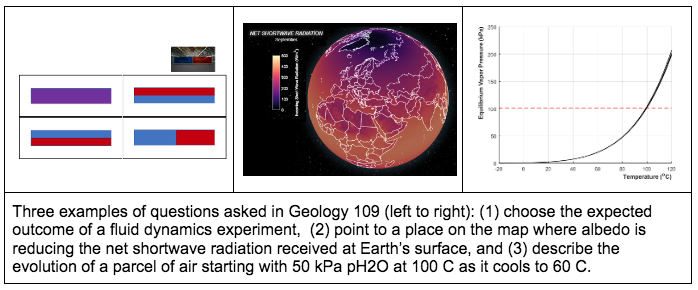Using Laser Pointers to Bridge the Gap between Student and Screen, and Gather Anonymous, Real-Time Student Feedback about their Learning in an Introductory Geology Course
Featured Faculty:
Image

Nicholas Holschuh

I
n the Fall of 2021, Professor Nick Holschuh taught the introductory Geology course entitled, “Climate Change: Science and Rhetoric” (GEOL 109). This course seeks to help students develop an interdisciplinary understanding of Earth’s climate system and explore the rates and impacts of climate change in communities across the world. Further, this course also emphasizes the challenge of misinformation and competing narratives about climate change in public discourse, and the ways that science communication and political goals intersect.
The course was initially designed to be limited in enrollment to 48 students. However, given a high level of student interest in the course, as well as the larger than average student population on campus, the course enrollment cap was removed and all told, Professor Holschuh found himself teaching GEOL 109 to 101 students that Fall. The class was moved from its original space in Beneski Building to Cole Assembly Room in Converse Hall, affectionately known as the red room for the crimson carpet that lines the steeply tiered, theater-style space. By its design, the red room put Nick on the stage and students in the audience, putting both physical and metaphorical distance between the course material and the students.

How could Professor Holschuh bridge that gap, to both gather real-time information about student understanding in such a large class and to help students feel like they can interact with him and the course content? Many instructors have employed clickers at the College – they are a great tool to collect responses to structured questions, but fail to give students the sense of agency and fun Nick was looking for. Instead, at the beginning of the semester, Nick reached out to his department to request the purchase of laser pointers for each student enrolled in the class. Acting like an extension of the arm, laser pointers provide students the ability to directly engage with material on the board, allowing them to highlight features and describe their thinking. The laser pointers close the space between student and content, giving everyone a presence at the front of the room that can feel missing when sitting 40 feet away.
How did he use laser pointers in the class? One use is as a clicker replacement – students can respond to multiple choice questions on the screen by pointing to their preferred answer. It maintains anonymity, provides immediate feedback, and engages student focus (in-so-far as it is more fun than hitting a button on a clicker). But as an analog tool, it allowed Nick to ask questions that engage students in ways that multiple choice questions can’t, asking an individual student to point to a place on a map of the world where a specific climate phenomena is experienced, or to plot a point on a graph where an expected result might occur. Outside of their structured use, students would use them to point to things on the board when asking questions of Nick, and when given time to discuss a plot or a concept with other students in class, Nick would often see lasers show up on screen as students used them as a tool to facilitate their own conversations.

In the end of course evaluations, students consistently noted how this pedagogical approach enhanced their learning and experience in the course. One student said, “The laser pointers were a really effective way of engaging the entirety of the class and getting answers from people who would normally not speak in such a large group.” Another student said, “The laser pointers were great and fun and snapped me out of ‘this is a very large lecture and I’m on note-taking autopilot [mode]’.” A third student simply said, “The use of laser pointers for group consensus during discussions was brilliant!”
A warning: Nick does want to note that the experience changes based on the classroom and students. The first attempt in the red room came with a rocky start, but after building trust (mainly Nick trusting the students not to lase each other or him), it was a highlight of the classroom experience.
| Attachment | Size |
|---|---|
| Fluid Dynamics Experiment Image | 75.88 KB |
| Net Shortwave Radiation Image | 137.04 KB |
| Evolution of a Parcel of Air Image | 85.08 KB |